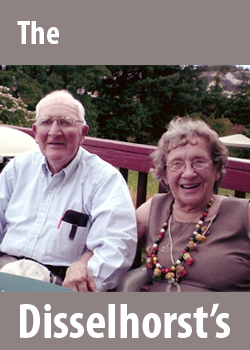Byron Disselhorst
When America entered WW II in Dec. 1941, Byron was a freshman at Oregon State University and he joined the Army Reserve sometime after that. He was able to finish his sophomore year in college, and then he was called up as were other students in his category.
He took basic training in Texas and then was put in the army specialized training program and sent to the University of Nebraska for six months before he was transferred to the 44th. Infantry Division in Kansas where he trained before going to Europe in Sept. 1944.
He went into combat in October assigned to the 7th Army. The weather was wet and cold, and by Nov. it was snowing. Around Thanksgiving time, his regiment was awarded a Presidential Unit Citation for repulsing the Germans in the Alsace-Lorraine region of France.
After the Battle of the Bulge, the Germans needed a diversion to relieve pressure on their divisions in the Ardennes where the first Army had regained the initiative. As a result, the Germans launched an attack on the 7th. Army on New Years Day. Byron was still in the 7th. Army and the lines were spread thin.
On Jan. 6, 1945, his company launched a counter attack and without going in to all the details he was captured in the afternoon after fighting most of the day. After brief stops in two POW camps and three separate box car train trips, he ended up in his final camp, Stalag 4A, near Dresden, Germany, in Feb. 1945. The box car trips were tough. One could either stand or sit, but could not lie down. One trip lasted six days and he had one meal and a little water.
The camp he was in was a work camp for enlisted POWs. He did pick and shovel work and got one bowl of watered soup and one slice of bread per day. He weighed about 90 pounds at the end of the war. He wore the clothes he was captured in until he was liberated. He had two showers during captivity and all in the camp had lice. At night he dreamed about food.
Byron knew the war was coming to an end by late April. About April 30 all left the camp and followed refugees trying to escape the Russians who were taking over. When the war ended in early May, he had reached Sudetenland in Czechoslovakia which was controlled by the Russians. He lived with a family for about two weeks before he finally was returned to American control and sent to France and home.
After discharge from the Army in Nov. 1945, Byron returned to Oregon State University and graduated with a BS degree in Chemical Engineering in June 1947. Most of his professional career was in the field of nuclear power research and development. Byron also served in the U.S. Air Force Reserve and received an honorable discharge with the rank of Captain.
He is now retired and involved in a variety of activities. His wife was a WW II Army Nurse and is also retired.
